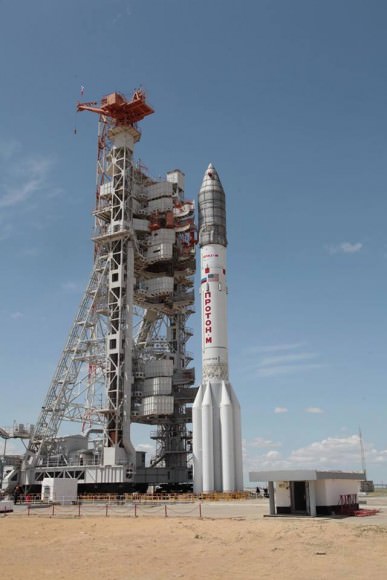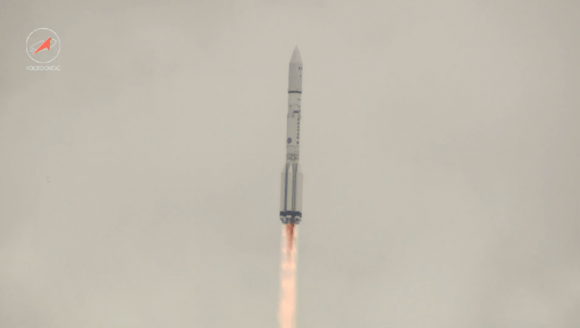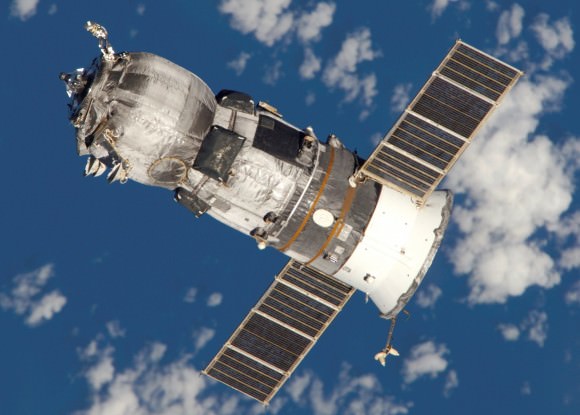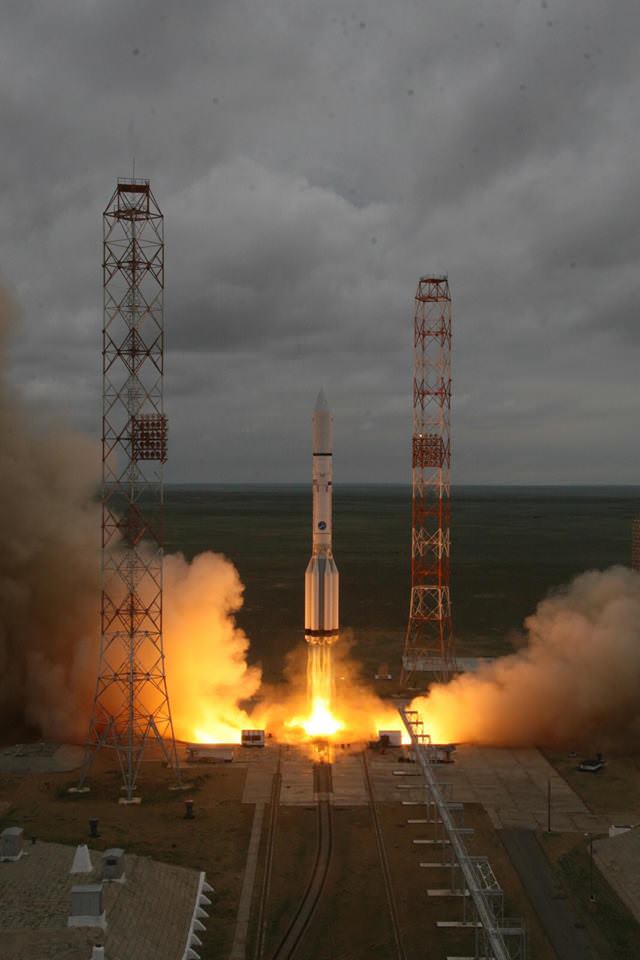Russian Proton rocket blasts off at 11:47 a.m. local time (1:47 a.m. EDT) from the Baikonur Cosmodrome in Kazakhstan but ended in disaster about eight minutes later with destruction of the rocket and Mexican comsat satellite payload heading to orbit. Credit: Roscosmos
Story updated with additional details [/caption]
For the second time in less than three weeks, a major disaster struck the Russian space program when the launch of a Proton-M rocket ended in catastrophic failure about eight minutes after today’s (May 16) liftoff from the Baikonur Cosmodrome in Kazakhstan, resulting in the complete destruction of the Mexican communications satellite payload.
The Proton-M rocket initially lifted off successfully at 11:47 a.m. local time (1:47 a.m. EDT, 547 GMT) from the Baikonur Cosmodrome in Kazakhstan, but soon experienced an “emergency situation at 497 seconds into the flight,” according to a brief official statement released by Roscosmos, the Russian Federal Space Agency today, after the mishap.
The launch catastrophe was caused by a failure in the rockets Breeze-M third stage, says Roscosmos. It took place during a live broadcast from the agency’s website. A video shows the rocket disappearing into cloudy skies shortly after liftoff.
The failure comes just one week after the spinning, out-of-control Russian Progress 59 cargo freighter bound for the ISS met its undesired early demise when it fell uncontrolled from orbit last Friday, May 8, following its botched April 28 launch on a Russian Soyuz-2.1A carrier rocket, also from Baikonur – as reported by Universe Today – here, here, and here.
The Proton-M carrier rocket was lofting the Mexsat 1 communications satellite, also known as Centenario, under a contract with the Mexican government.
“The failure happened on the 497th second of the flight, at an altitude of 161 kilometers [100 miles]. The third stage, the booster vehicle and the spacecraft almost completely burned up in the atmosphere. As of now there are no reports of debris reaching the ground,” the agency said in a statement.

The Breeze-M third stage was to loft Mexsat 1 to its destination in geostationary orbit over 22,000 miles above Earth at 113 degrees west longitude.
The 58.2 m (191 ft) tall Proton rocket is built and operated by Khrunichev State Research and Production Space Center and marketed by International Launch Services (ILS).
After reaching an altitude of about 161 km (100 mi) the rocket and Mexsat 1 payload fell back to Earth and burned up over the Chita region of Russia, which is located south west of the Siberian Baikal region, said the Russian News agency TASS.
“The rocket and its payload, a Mexican communication satellite, burned up in the atmosphere,” according to a report by Sputnik International, a Russian News agency.
At this time, local residents have not reported or claimed anything regarding possible debris and there is no information about casualties or destruction, TASS noted.
Mi8 helicopters from Russia’s Emergencies Ministry have been dispatched to the area to look for any debris.
The 5.4 ton Mexsat 1 communication satellite was built by Boeing Satellite Systems International for the Mexican government’s Ministry of Communications and Transportation, the Secretaria de Comunicaciones y Transportes (SCT).

The Breeze-M failure occurred about 1 minute prior to separation of the third stage from Mexsat 1.
“The emergency situation happened at 08:56 Moscow time, one minute to the scheduled separation of the Breeze-M booster and the Mexican MexSat-1 space apparatus,” TASS reported.
A malfunction with the third stage steering engine may be the cause of the doomed flight.
“A preliminary reason of the accident with Proton is a failure of the steering engines of the third stage,” sources told TASS.
“The analysis of the telemetry allows for supposing that there was a failure in one of the third stage’s steering engines. This is now considered as one of the main reasons.”
Exactly one year ago, another Proton rocket crashed at a similar point when the third stage engines failed during the Proton launch of Russia’s advanced Express-AM4R satellite.
“Khrunichev and International Launch Services (ILS) regret to announce an anomaly during today’s Proton mission,” ILS said in a statement issued after the launch failure.
ILS said an accident investigation board has been appointed to determine the cause of the failure and recommend corrective actions.
“A Russian State Commission has begun the process of determining the reasons for the anomaly. ILS will release details when data becomes available,” said ILS.
They hope to return the workhorse Proton to flight as soon as possible.
“ILS remains committed to providing reliable, timely launch services for all its customers. To this end, ILS will work diligently with its partner Khrunichev to return Proton to flight as soon as possible.”
This was the eleventh failure of the Proton-M rocket or Breeze-M upper stage in 116 launches since the inaugural liftoff in April 2001.
Mexsat 1 had a planned lifetime of 15 years. It was to provide mobile satellite services to support national security, civil and humanitarian efforts and will provide disaster relief, emergency services, telemedicine, rural education, and government agency operations.
Media reports indicate it was insured for about $390 million.

Stay tuned here for Ken’s continuing Earth and planetary science and human spaceflight news.


And our space shuttle was scuttled why?
would like the answers listed by order of relevancy or alphabetical order ?
Crew safety, financial performance and that it’s operator wants to go beyond low earth orbit.
Safety is a correctable idea that needs participation at all levels. When you have managers unwilling to listen to engineers or lesser staff for their concerns, then that causes problems. Both shuttle accidents were preventable at different stages. The idea that safety is a reason can also be applied to everything that lifts off in a rocket. Do you really think having solid rockets who’s technology was responsible for one of the shuttle accidents is really the safest way to get astronauts and equipment into space?
Certain parts of the various shuttles (like the hydrogen storage spheres) were passing their design lifetimes, especially on Columbia. Luckily these were designed to be replaced. Unfortunatley the contractors who made them have gone out of business (this is the case with many of the shuttle’s components). In the case of the spheres, new ones could have been designed and qualified – blueprints exist, of course – but it would have been a long, expensive process.
We see the same problems at Boeing today with their Russian Atlas 5 engine. They know how to build engines themselves, and are even licensed to do so by the Russians, but learning the little intricacies of the task, testing, and then finally qualifying the engines for flight would take five years and cost as much as a brand new engine. Boeing has determined that if the process is going to take as much time as designing, building, and qualifying a whole new (more modern) rocket, they might as well build a new rocket (Vulcan).
NASA was slowly getting into a similar predicament with the Shuttle. And they totally saw it coming. That’s why things like the X-33(see note 1), X-37 (note 2), and X-38 (note 3) programs existed. They were intended to be shuttle replacements. They were being designed for the same reason Boeing is building Vulcan: if building a new system would cost the same amount as recreating your existing (1960s era tech in the case of the shuttle) system, you might as well modernize your fleet.
Unfortunate NASA was never allocated the money to either fix the shuttles or (more realistically) replace them with a far superior fleet. And here we are today:P.
Note 1) AKA VentureStar – cancelled after Lockheed overpromised and underdelivered, while sucking up massive amounts of money. Typical Lockheed.
Note 2) Later transferred to the Airforce and still in use today.
Note 3) Essentially an older version of the Dreamchaser, based on the HL-20 prototype.
Dah dah… big problem! It looks like either Ivan is loosing his grip? OR perhaps the technical engineering corps. in Russia is making a statement? Maybe a scapegoat is needed here… blame the Ukranians?
They are sending these things up at the rate of about 8-10 each year, so even losing one a year the success rate is still OK for unmanned launches, provided the payload is not something super-expensive.
The Mexs should have un-mated their sat the moment they knew it was going to be the jinxed Proton booster. Learn the hard way i guess.
To the US Shuttle program. What still bothers me in no small way is that, we knew at some point they were either:
A. Going to need serious upgrading.
B. Time to start building Shuttle 2.0. For deeper space flights. Read: to the Moon. It could hold a crew, sleeping quarters, mini science station and it could hold a Moon Lander, it could fly back and it could land…..
Yes, a little more ‘expensive’ – but it is reusable and thus save in the long run.
I’ve never understood turning this all over to Russia, I just never did. It was and is a stupid move. Sorry it is.
10 failures in 91 launches is a rate of 11% – no one would accept that on a mature system. No other current launcher is THAT bad.
Taurus and Antares might come close. Orbital has a terrible record on most of their rockets in the past decade. It’s a wonder anyone uses them.
Someone please tell the photographer of the first photo to clean their camera sensor.
I know, it sounds trivial after reading gopher65’s well written and insightful post, but, well, just clean that sensor.